Castor oil plant: description, varieties and cultivation
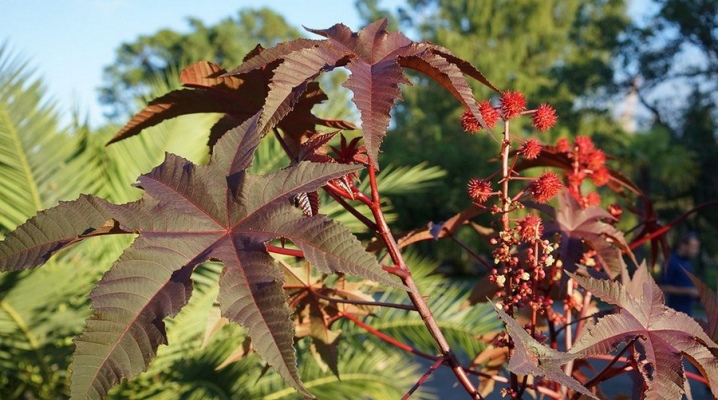
Castor oil plant is a very poisonous, but at the same time quite spectacular plant, which many novice gardeners want to grow. In this regard, the question of planting and the rules for caring for shrubs remains relevant.
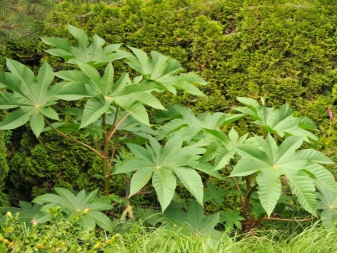

Peculiarities
Castor oil plant (Latin Ricinus) - typical representative of the euphorbia family (Euphorbiaceae). The genus is represented by one single species: castor oil plant (lat. Ricinus communis). The plant belongs to the category of medicinal and has a number of useful properties. In addition, castor oil has high decorative properties and is able to add variety to even the most dull landscape.
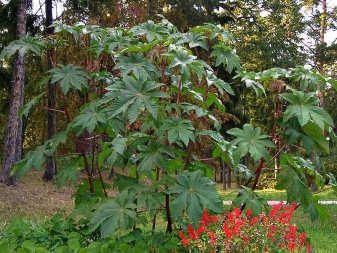
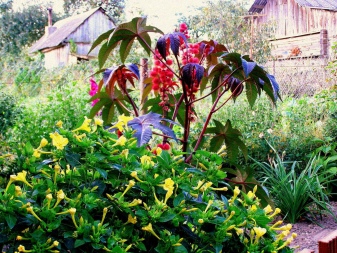
Where does it grow?
There is no reliable information about the birthplace of castor bean, however most experts believe that the plant came from Ethiopia... According to scientists, it was from there that it successfully spread throughout the tropical and subtropical zones of the globe, where it is still found in wild species.
It is known for certain that in Egypt castor bean has been cultivated for more than 2 millennia, as evidenced by the seeds found in the tombs of the royal people buried in the III-IV centuries. BC.
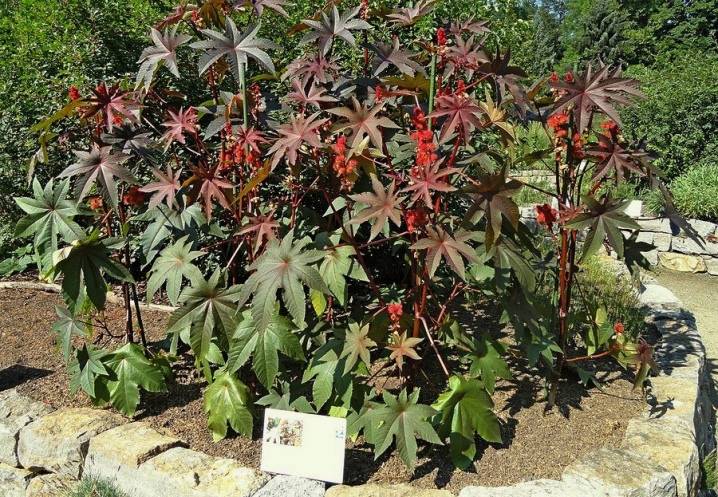
Today, perennial varieties of castor bean can be seen in the wild in countries such as Iran, India, Brazil, Argentina and China... Each of them has been well studied and given a botanical description. In Russia, due to the absence of tropical zones on its territory, they are engaged in the cultivation of annual varieties of castor bean. For its exotic appearance, the bush is often called "palm", as well as "paradise tree", "castor oil" and "Turkish hemp".
Annual varieties are significantly inferior in growth to perennials and stretch only up to 2 m, while wild varieties often reach 10 m.
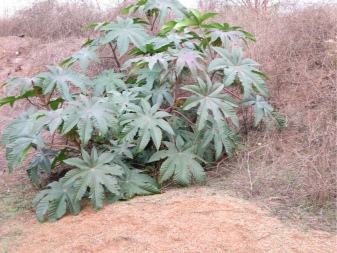
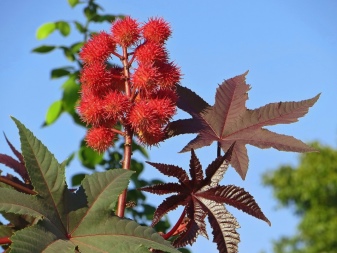
What does it look like?
The castor oil plant owes its name to the shape of the seeds: brown, in beige patches and with 2 spherical outgrowths, they are very similar to ticks. Wild perennials are tall tropical trees, while "Domestic" annual varieties are herbaceous shrubs and resemble exotic plants in the tropics in appearance... They stretch up to 2–5 m, have erect hollow stems of black, pinkish, red and purple flowers and beautiful alternate leaves. The shoots branch well and are covered with a waxy bloom of a bluish tint.
The leaf plates grow up to 30-60 cm, have a finger-like divided structure, an uneven-toothed border, green petioles 20 to 60 cm long and consist of 5-11 lobes.
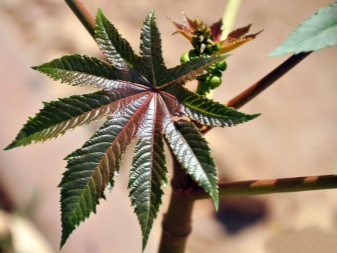
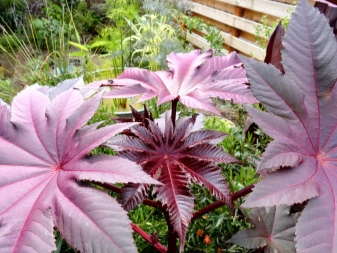
Small flowers form inflorescences of racemose terminal or axillary types and are represented by both male and female variants. At the same time, male (with pistils) are concentrated in the upper part of the inflorescence, and female (with stamens) - on its lower part. Castor bean fruits are beautifully arranged between the leaves and are presented in the form of naked or spiny bolls up to 3 cm in size. In color, the boxes are yellow, pink, scarlet and purple. Seed color varies from copper-red to grayish with a beautiful mosaic pattern of brown and pink flowers.

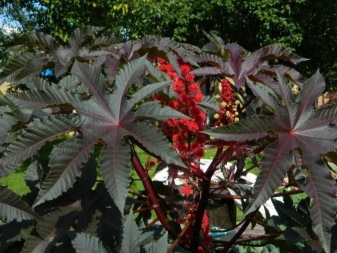
Virulence
Castor bean seeds contain 40-60% fatty oils, and the seed nucleus consists of 17% proteins, among which are the very poisonous toxalbumin ricin and the no less dangerous pyridine alkaloid ricinin. When these poisons enter the human body, severe vomiting, colic and bleeding from the digestive tract begin. At the same time, the water-electrolyte balance is disturbed, and a week later the person dies. If help is provided in a timely manner and the patient survives, then he will not be able to fully recover his health. This is because ricin destroys tissue proteins and has no antidote.
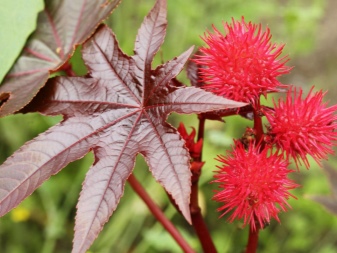

Application
Using the cold pressing method, castor oil is made from castor bean seeds. To neutralize the toxic properties of ricin, the resulting substance is doused with steam, which leads to the decomposition of this chemically unstable substance during hydrolysis. Castor oil is an effective laxative and stimulates muscle contraction.
Due to this property, at one time the drug was used in obstetrics at the weakening of contractions. In modern medicine, pure oil is practically not used, but often added to the composition of balsamic linimentwith antiseptic properties and designed for rapid tissue regeneration.
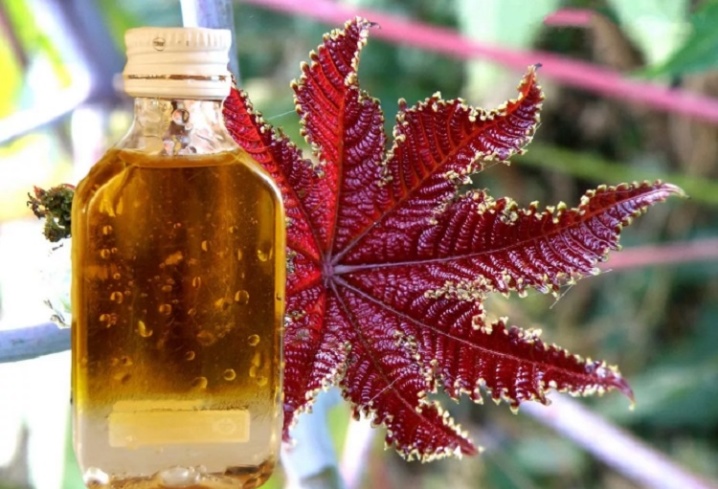
In addition to medications, castor bean seeds are used to make lubricants that are used even in highly accelerated aircraft internal combustion engines. This is due to the ability of fats of a toxic nature to remain in a viscous state at any temperature.
Types and varieties
One species - castor oil plant - has a large number of varieties. In Russia, undersized annual bushes are grown, which are ideal for decorating a garden and often act as one of the central elements of landscape design.
- Variety "Impala bronze" is a fast-growing ornamental shrub 1.2 m high with erect branched stems and palmate-separated leaves of green and bronze-red shades. Bright red flowers are collected in dense racemose inflorescences. The plant prefers warm, light areas and withstands short-term drought well.
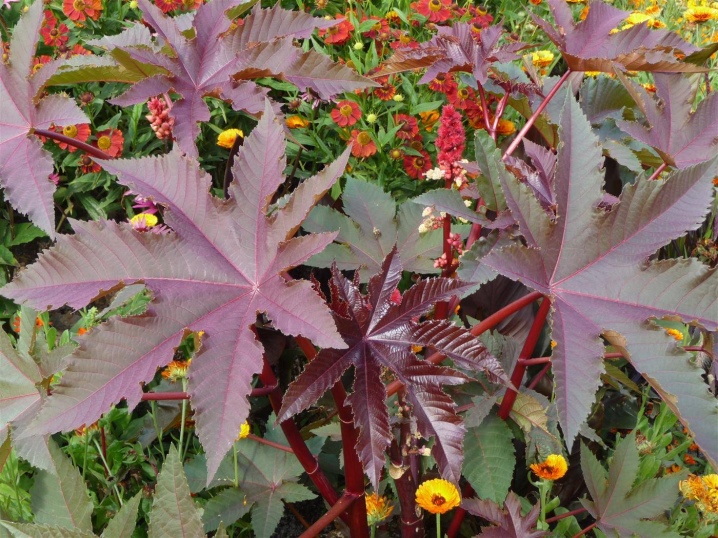
- "New Zealand Purple" has huge dark purple leaves and a massive burgundy stem. The plant is undersized and has good decorative properties. It is often planted near the house in a group planting consisting of several bushes of the same variety.
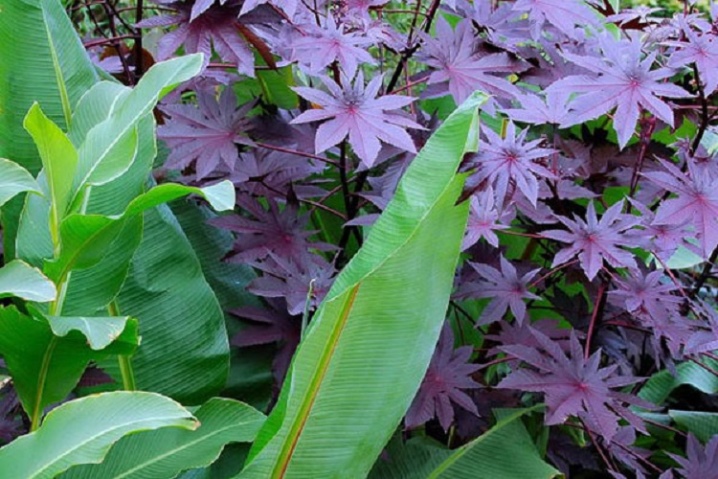
- "Carmencita" is considered one of the brightest and most unusual varieties of castor bean. On beautiful red shoots are no less attractive carved leaves of a red-burgundy color, and during flowering, the bush is covered with lush pink-green inflorescences. The plant grows quickly and reaches a height of 1.5 m by mid-summer.
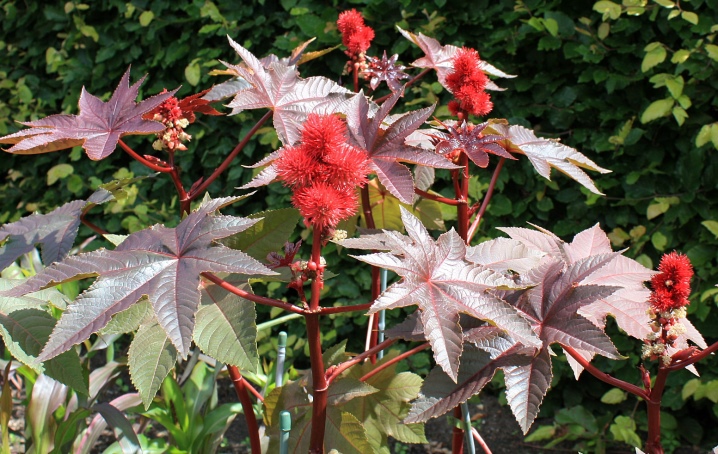
- "Northern palm" is a woody annual plant up to 2 m high. It looks great as a single planting and is often used for landscaping front gardens. The plant has beautiful leaves with a diameter of 30 cm and small nondescript flowers that form inflorescences up to 30 cm long.
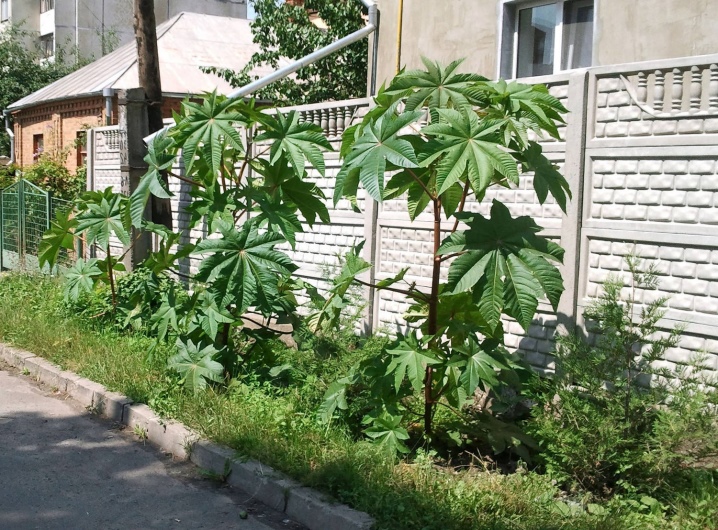
- "Zanzibar Green" belongs to tall, fast-growing varieties and grows up to 2.5 m during the season. The shrub has beautiful bright green leaves and dense racemose inflorescences consisting of red flowers. This variety looks very elegant and is in great demand among summer residents.

- Castor oil Gibson is a very attractive variety and is distinguished by its short stature. Over the summer, the plant grows only 1.5 m and has dark green foliage, decorated with burgundy veins. At the end of summer, a metallic sheen forms on the surface of the leaf plates, which makes them look like stars.
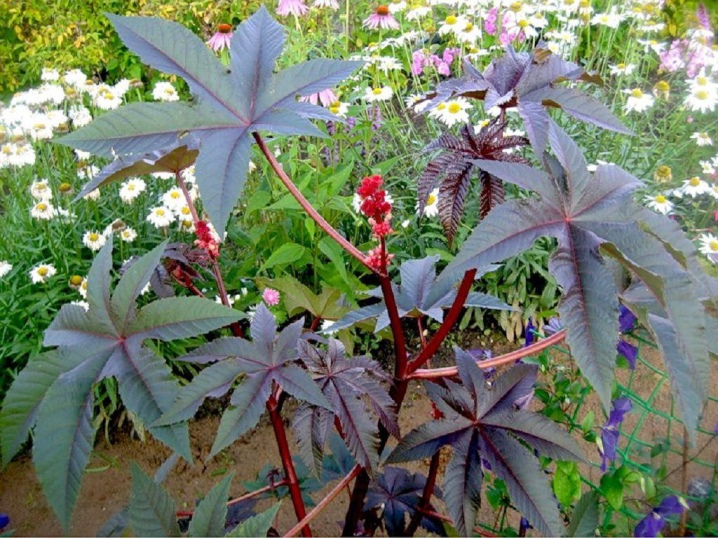
- Castor oil bourbon belongs to tall varieties and reaches a height of 3 m. Due to the presence of a thick trunk up to 15 cm in diameter, the plant is often called a garden palm. The leaves have a shiny surface and are colored in dark green tones.
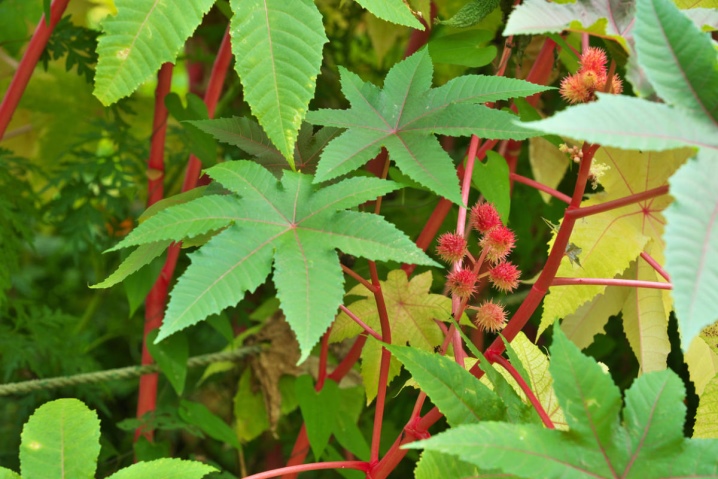
Sowing seedlings
The castor oil plant is propagated by seeds.In the southern regions, they are sown directly into open ground, and in colder regions they are used as a seedling method. Seeds for sowing are harvested in the first decade of September, using strong plants with a spectacular color. At the same time, the seed pods are carefully cut from the bushes and laid out in a warm, dry room to dry. They dry out for a long time and become ready for the extraction of seeds not earlier than the beginning of December.
The box is lightly pressed on both sides, after which it opens completely, and the seeds spill out. Each box contains 2-3 seeds, you need to work with them only with gloves. It is necessary to store the seed out of the reach of children and animals, spreading it out in paper bags.
Germination rate lasts for 4 years and is 30-40%.

Castor bean seeds have a very dense shell that makes germination difficult. Self-propagating wild varieties throw them to the ground, where they are quickly pecked by birds. The seeds pass through the birds' digestive tract, where the hydrochloric acid softens the thick skin.
Then they return to the ground and sprout very quickly. To facilitate germination at home, the peel is slightly filed with a file or sandpaper, thereby violating the integrity of the seed cover. Then the seeds are soaked in warm water, to which a little "Epin" or "Heteroauxin" is added.
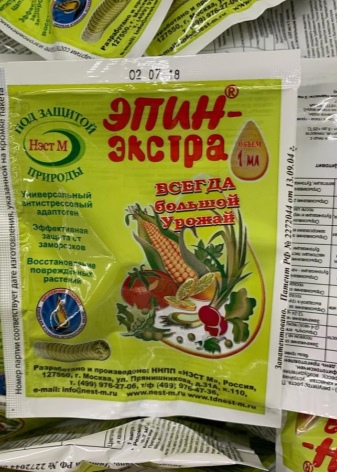

Sowing castor bean seeds for seedlings begins in the 2nd decade of March, using seedling peat pots with a volume of 1 liter. The container is half filled with a mixture of peat, sand and humus, taken in equal shares, and the seeds are planted, deepening them no more than 2 cm. It is recommended to use a separate container for each seed. Scarified seeds germinate after 4 days, after which the remains of the sticky peel are removed from the young leaves with tweezers.
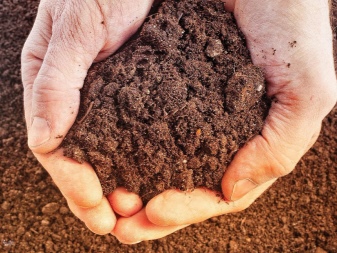

To prevent the seedlings from growing rapidly, the pots are placed in a bright place. At the same time, the air temperature should not fall below 17 ° C. Watering the seedlings is carried out only with warm water under the root, trying to prevent stagnation of liquid in the root zone.
Castor bean begins to grow very actively, therefore, as it grows, soil is poured into the pot. Usually, by the time of transplanting into open ground, the seedlings grow to 80-100 cm.If the transplanting time has not yet come, and the plant is too elongated, it is transplanted into a larger pot using the transfer method.

Landing in open ground
When choosing a place for castor oil plants, it is necessary to understand that the plant is considered to be highly poisonous, and therefore should be as far as possible from playgrounds and public spaces where children may be. Castor oil loves sunny, windless areas located near the walls of houses or fences. At the same time, the soil should have a neutral reaction, be moist and rich in humus. Depleted soils are fertilized with manure at the rate of 10 kg per 1 m2 and carefully dug up.
Wood ash (0.25 kg / m2) and mineral preparations for flowering plants are also added to the ground.


They begin to plant castor bean seeds in open ground only after the threat of night frosts has passed. In the south of Russia it is the end of April, and in the northern regions it is the end of May or the beginning of June. The pre-fertilized area is well spilled with water, allowed to absorb and the pre-scarified seeds are buried by 3-5 cm.The distance between neighboring plants is chosen depending on the castor bean variety, usually 70-150 cm.

Then the grains are sprinkled with a nutritious substrate and wait for the emergence of seedlings. At the same time, you need to know that castor bean seeds do not differ in 100% germination, and in the best case, out of 10 grains, 3. Therefore, experienced summer residents place 2-3 seeds in one hole, thereby increasing the probability of germination.
The first shoots appear after 14-28 days, after which they rapidly go into growth and by the second half of summer they grow under 2 m. If it is decided to grow castor oil plants at home, for example, in a winter garden, then it should be borne in mind that the plant has a rod-type root, and therefore needs a flowerpot with a height of at least 1 m.

Transplanting seedlings into open ground is performed in the 3rd decade of May, after the threat of night frosts has passed. Beforehand, the seedlings are well watered, the water is allowed to drain, and the bushes with a clod of earthen are carefully transferred into the prepared holes. If the seedlings were grown in peat pots, then they are planted in the ground along with the container.
After transplanting, the soil around the trunk is slightly compacted and the seedling is watered again. Next to the trunk, a number of support is driven in, which will support the tall plant and will not allow it to fall under the gusts of wind. This is due to the rod-type root system, which sometimes is not able to hold a tall bush.

Correct care
Due to its complete unpretentiousness, castor bean can be grown in any climatic zone of the country, with the exception of the northern territories. To do this, it is necessary to observe some rules of agricultural technology, which provide for timely watering, top dressing and soil care.
Watering
The castor oil plant needs regular watering, so every 3-5 days, a bucket of water heated in the sun is poured under each bush. With a lack of moisture, castor bean leaves lose their elasticity and sag, as a result of which the plant loses its attractiveness.

Top dressing
When growing castor bean, you should not forget about additives. The plant loves organic substances, which are used as humus, manure or bird droppings. They are brought into the soil in the spring, shortly before planting. The use of potassium-phosphorus preparations is allowed only on the eve of flowering.
Soil care
Castor oil needs permeable loose soils, which is why they must be loosened and weeded as often as possible. To preserve moisture in the root zone, they resort to the mulching technique, using straw, tree bark or peat for this.

Diseases and pests
Castor oil plant is distinguished by strong immunity, so even a novice gardener can grow a healthy plant. To do this, you just have to carefully monitor the condition of the bush and immediately take action at the first suspicion of an ailment.
- The most common disease affecting castor oil plant is considered fusarium, the first signs of which are yellowing and wilting foliage, cessation of bush growth and the appearance of purple stains on the stems. If the disease is recognized in time and fungicides are applied, then the plant can be saved.


- A more dangerous disease is microsporosis, in which brown spots appear on the leaves, which quickly dry out and crumble. The foliage falls off in a matter of days, and the plant completely loses its attractiveness. If a diseased plant is found, it is recommended to dig it up and burn it, and treat the rest of the bushes with chemicals for prevention. The danger of this disease is that its pathogen tolerates winters well and affects new plants planted in the place of a diseased bush.
To avoid disease of young bushes, the soil is treated with a dark solution of potassium permanganate.
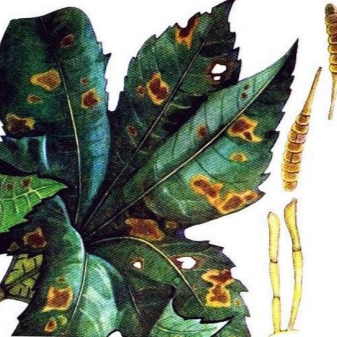

- And also castor oil plant is sick with powdery mildew, late blight and various rot... If any of these diseases is detected, the bush is treated with Bordeaux liquid as soon as possible, and in case of severe damage, it is dug up and burned.

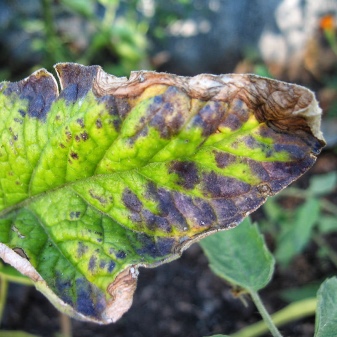
As for pests, then occasionally attacks by wireworms, caterpillars and meadow bugs... An infusion of bitter wormwood or garlic helps to get rid of insects. To prepare wormwood infusion, 1/3 of a bucket of chopped grass is poured with boiling water, insisted for a day, after which the bushes are sprayed.
Garlic infusion also gives good results, for the preparation of which a glass of garlic is chopped and poured into a bucket of hot water.You can also use a biological method of protection against pests by planting coriander, mint, parsley or dill in the immediate vicinity of the castor oil plant. Insects do not tolerate the smell of herbs, so the plant will be safe.

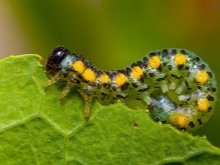
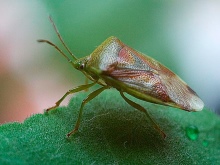
Use in landscape design
You can plant castor oil in the country, in the garden or on the site. The plant looks great both in a single planting and in the company of others of its kind (3-5 pieces each). Mixed groups with tall species do not give the expected effect and are rarely used. This is due to the fact that the plant is gorgeous in itself and does not really need companions.
But in an ensemble with low cultures and flowers, almost all varieties look very harmonious. Castor oil is especially well combined with dahlias, monarda, daylily, mallow, phlox and large-flowered marigolds.
Interesting examples:
- castor oil plant as a central element of a flower bed;
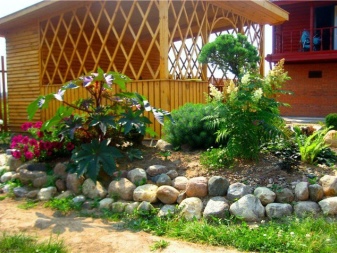
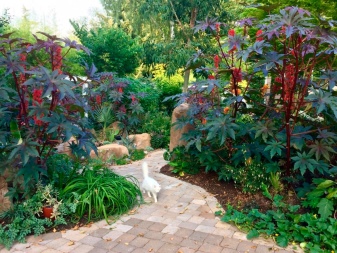
- Zanzibar castor oil plant in the design of a summer cottage;


- undersized variety goes well with many garden species;

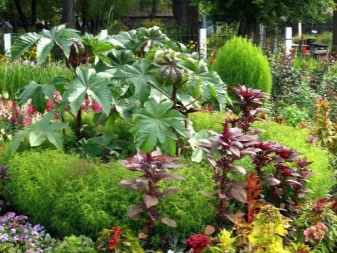
- during flowering, the plant is just gorgeous;
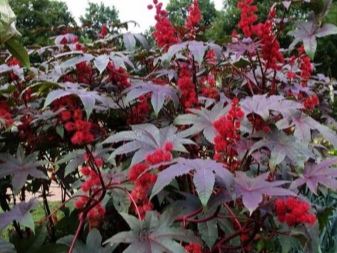
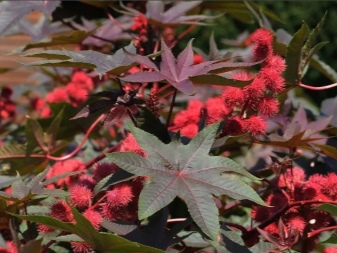
- castor bean hedge looks very exotic.
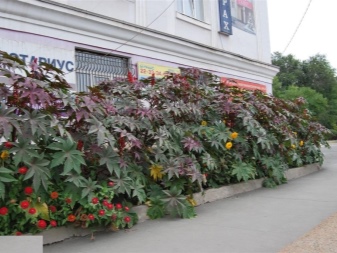
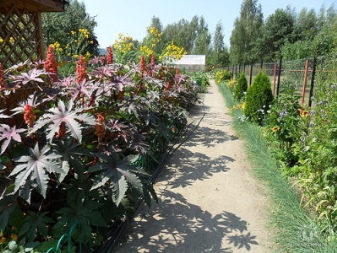
The following video will tell you about the intricacies of planting and growing castor bean.



































































The comment was sent successfully.